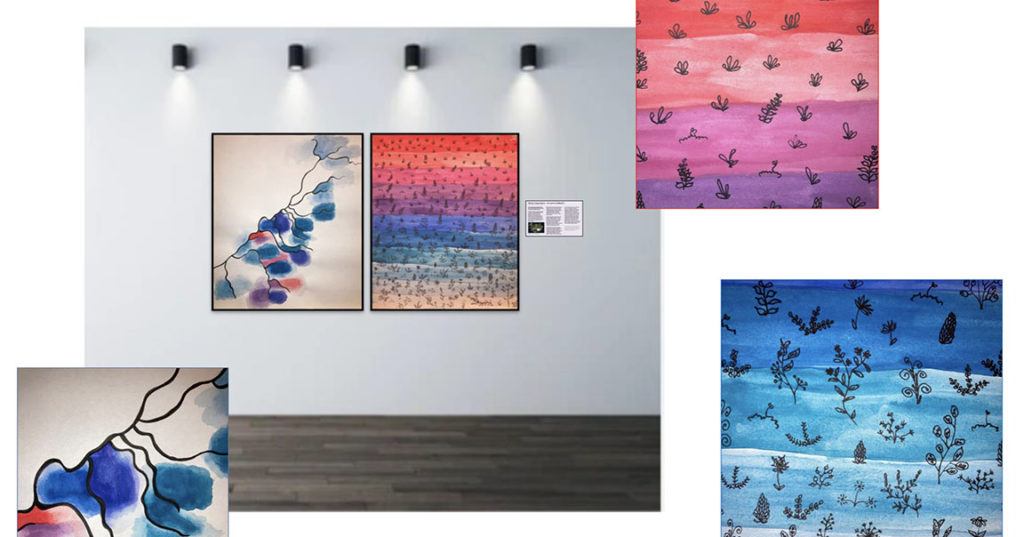When art meets science: Peak District podcast, watercolour painting and animating Mars
You may be surprised to read about watercolours and gallery walls in a piece on geothermal gradients, but just stick with us for a second…
While it’s no secret that creativity and the sciences are undoubtably linked, this concept takes on a whole new meaning in the science communication module that’s open to final year Earth and Environmental Science students.
Designed to empower the expertise they’ve gained during their degree; students are encouraged to source new and exciting ways to engage research with a wider audience. From writing articles and creating podcasts to designing museum exhibits and directing videos, students have free rein to get creative and interpret a scientific article through unique mediums and abstract art forms.
Take a look at some that really caught our eye!
Project One: Paintings and Places
Emily’s project takes root in a very striking research paper, one exploring how temperatures affect plant diversity along geothermal gradients in Iceland. She chose the unique medium of painting to convey the research findings…
The aptly named Warmer Temperature – Fewer Species takes shape as a diptych, proclaiming the documentation of these research findings in an open book-like manner. Usually seen in religious altarpieces, Emily’s diptych paintings serve as both a warning of the future and a recording of the current moment.
The piece discusses how the higher the soil temperatures are around the Hengill Rivers, the smaller the number of species found. Emily’s use of watercolour paints captures the fibrous-nature of the painting’s subject, while the transcending colour palette emulates the changing lineage and temperature of the landscape.
“I think that well-done figures and images can convey so much more than a hunk of text, especially for anyone without extensive knowledge of academic terminology or time to read an extensive paper,” she says.
“That is why I thought of combining art with the communication of science. I [used] watercolours and fine liners [to paint] the results and setting of the paper I chose.”

Project Two: Woodland Wanderers
Alice’s project began with a simple vision: encourage people to put their boots on and head outdoors. Woodland Wanderers bloomed from this humble belief.
A fictional podcast series tailored to UK-based hikers, the series spotlighted specific trails in the region’s iconic landscapes, including the Peak District and Lake District National Parks. Each episode delves into a chosen hike and highlights an environmental initiative in that area.
“Hiking has been proven to have great medical benefits, as well as promote ways in which the public can help protect wildlife,” Alice says. “Each episode can be listened to before or during a walk, guiding listeners on what they can observe during their hike, while imparting scientific insights into environmental practices in the area.”
For example, Episode Three shifted focus on the rewilding of beavers to the Knapdale Forest in the west of Scotland. The six-minute insight had a purposeful message “to promote public awareness of this conservation effort, so it is not disturbed or damaged by hikers.“
Project Three: Helicopter on Mars
Ronan’s project took on the great unknown of space, and specifically, our neighbouring red planet. His intuitive and engaging animated video covered the ins-and-outs of sending the Ingenuity Helicopter to Mars alongside the Perseverance Rover.
Recounted through compelling narration and ‘cartoon-ified’ characters, Ronan took this research paper and decided to make it a story. After all, if the last few decades of cinema suggest, people love a good sci-fi!
The short included challenges faced by NASA in the project and designing a helicopter to succeed in a Martian environment.
“I tried to convey the information from the paper in an educational video format that most people would be able to understand and enjoy,” Ronan says. “Sadly Ingenuity was permanently grounded earlier this year on the 18th of January due to rotor blade damage whilst landing, but 72 flights over almost 3 years is still pretty good!”
If you’re on one of our courses and interested in science communication, why not explore the options available to you in your science and engineering degree. Ask your lecturer or course administrator for more information.
communicationsEarth and Environmental Sciencepeak districtSpace




